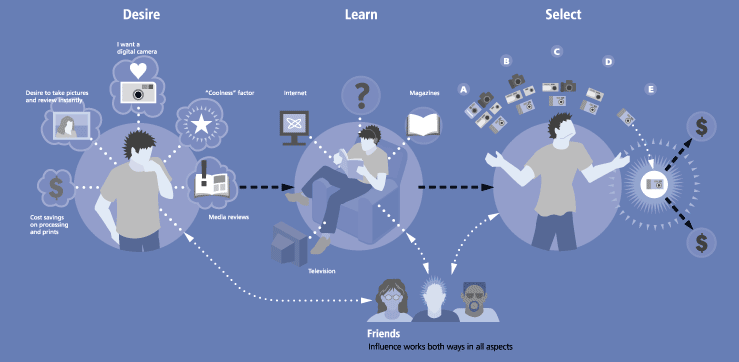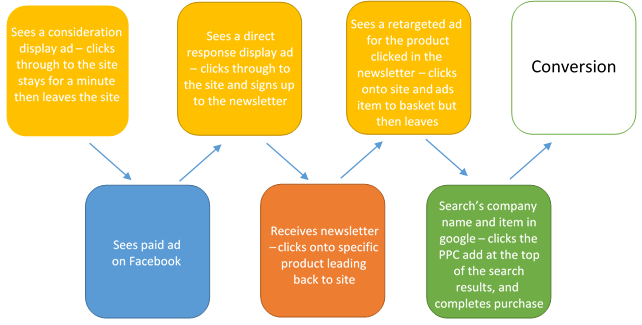What is Attribution Modelling and why do we need it?
Aimlessly spending marketing budget on digital marketing can be very costly to a business. Fifield, P (2008) admits that although in marketing there will always be leakage in spending it is important to identify where this is so it can be minimalised. According to Banasiewicz, A. (2013), actions taken on successful tracking and analytics of big data is the key to this. But how do you analyse all this data at your disposal? Attribution modelling!
Attribution modelling is how you attribute value to the different channels that contribute to conversions or sales on your website (Ryan, D. 2014). This can then be used to make better decisions with your digital marketing efforts. The models are the sets of rules which are used to determine how the conversions and sales are attributed to different touch points along the conversion path.
First of all let’s create an example scenario with “company ABC” which illustrates the need for a more rigorous attribution modelling system by outlining the issues with the previously used last click attribution (LCA) model. LCA uses information taken from the piece of marketing that, as the name suggests, was last clicked on before the customer converted (Phillips, J 2014), where a conversion is defined by the company. A conversion can be a newsletter sign up or a complete sale for example. The effectiveness of the marketing is then directly attributed to that last piece of marketing and the complete online customer journey is disregarded and forgotten about. Marketing analysts looking at an LCA model would then look to weight the marketing spending towards this “more effective” channel. Let’s look at the implications of this:
Below are four channels of online marketing that company “ABC”, for example purposes, are using. Then below each of these are the value attributed to them via a last click model based on their conversion, which for ease we will count as a sale.
From the above it looks like PPC marketing is the most effective means of generating sales. However the consumer’s journey has not been completely considered at all. The method of working out how marketing spend should be assigned should not be as black and white as solely looking sales figures drawn from the last piece of marketing interacted with. Certain marketing methods are used to purely generate consideration for the product or service and thus are unlikely to immediately generate a sale yet are still important to the customer journey (Schönhoff, A 2014).
Below I have created an example of a consumer’s purchasing journey which should more accurately show that there is more to be considered than just the last click a customer makes, and also demonstrate the value of the entire marketing plan as a whole. The boxes are colour coded to reference the channels above that the marketing activity stated is part of.
As you can see this user journey has a lot of touch points from a digital marketing perspective and using the LCA model all of this customer’s conversion would be attributed to PPC as it was the last piece of marketing they clicked before converting. A good way to view a customers journey is to use Google think, an excellent tool to understand how certain acquisition channels assist conversions in your industry and how the length of the customer journey impacts the final sale.
The clicks and impressions achieved via display, social media and email marketing must have aided the conversion to some extent so we need a way to analyse that and see how they form part of the sale. We do this by observing our data through multiple attribution models and deciding which works best for the data available. Other models include (Phillips, J. 2014):
- First click – where the entire value of the sale is attributed to the first piece of marketing in the conversion path
- Linear – where value is evenly attributed across every element of digital marketing in the conversion path
- Time decay – where more value is given to the most recent piece of marketing to the final conversion and consecutively less to the rest of them with the least being the piece of marketing furthest from the conversion
- Position based – where value is attributed based on position of the marketing. For example more value is attributed to the first and last interaction in the conversion path than those in the middle
However, the point is not to choose the best model and stick with it, but rather to use all of the models to gain an insight into the conversion path and then efficiently weight digital marketing spend based off of these decisions.
Are there downsides to Attribution Modelling?
Attribution modelling can’t answer all of our digital marketing needs exactly and generate the perfect model of where digital marketing budget should be spent. Kaushik, A. (2013) says that “A lot of that [problems with attribution modelling] is because of all the stuff we don’t know. There is lots of missing data. And as if that were not enough, there is lots of unknowable data”. This suggests that there is only a certain level of efficiency in this current digital climate that can be reached.
On top of this, firms rarely put all of their money into digital marketing. Offline marketing can’t (yet) be attributed to individuals and linked back to their online activity. This allows potential for other marketing channels to impact the online journey of the user and thus skew results of their online consumer path.
Conclusion
In conclusion, a successful attribution modelling system can help a company generate a more refined digital marketing strategy, aiming toward a maximised return on investment across all digital marketing channels. A lack of information may make it impossible to generate a perfect model that tells a firm precisely how their money should be spent, but using a window with multiple models allows for a more efficient budget allocation. This shows us that no single model is better than the sum of them all combined.
References:
Banasiewicz, A (2013). Marketing Database Analytics: Transforming Data for Competitive Advantage. New York: Routledge. p3.
Fifield, P (2008). Marketing Strategy Masterclass: Making Marketing Strategy Happen. Hungary: Elsevier. p203.
Kaushik, A. (2013). Multi-Channel Attribution Modeling: The Good, Bad and Ugly Models. Available: http://www.kaushik.net/avinash/multi-channel-attribution-modeling-good-bad-ugly-models/. Last accessed 12th April 2016.
Phillips, J (2014). Building a Digital Analytics Organization: Create Value by Integrating Analytical Processes, Technology, and People into Business Operations. New Jersey: Pearson. p157.
Ryan, D (2014). Understanding Digital Marketing: Marketing Strategies for Engaging the Digital Generation. London: Jellyfish. p77.
Schönhoff, A (2014). Does Multi-stage Marketing Pay?: Creating Competitive Advantages Through Multi-stage Marketing. Berlin: Springer Gabler. p25.



thank you for writing about attribution. This has been, and will continue to be, a key topic and challenge for digital marketers… I enjoy every article and conversation on the subject.
https://advanced-attribution.com/